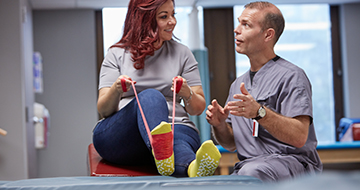How can I assess my knee/hip pain?
If you experience pain and chronic stiffness when walking, standing or getting up from a chair, or if you simply can't do the things you enjoy doing, the orthopedic surgeons affiliated with Saint Francis Joint and Spine Center may be able to help. Patients
who suffer from neck, back or leg pain may need the latest procedures for treatment of these problems involving the spine. Our goal is to help in the process of relieving your pain and restoring your mobility and freedom of movement.
What is joint replacement?
Joint replacement surgery involves replacing a damaged joint with a new one called a prosthesis. These new joints usually are made of special metals, such as stainless steel or titanium, and durable, wear-resistance plastic. Prostheses are designed to
be accepted by the body and resist corrosion, degradation and wear so they can last at least 10 to 15 years. Hips and knees are the joints replaced most often, but shoulders, fingers, ankles and elbows can be replaced as well.
Joint replacement is usually considered after exercise, walking aids, physical therapy or medications cannot relieve pain and improve mobility. Surgery for hip replacement patients, for example, can help lessen problems walking up and down stairs or make
it easier to stand from a seated position. Joint damage is caused by osteoarthritis, injuries, other diseases, joint wear caused by years of use, bone tumor or blood loss due to insufficient blood supply. Symptoms of joint problems include pain, stiffness
and swelling.
Treatment Options
Before surgery, the surgeon evaluates the patient’s range of motion and joint strength, takes a medical history and reviews medications currently being taken. Blood tests and X-rays also can be ordered. The doctor may put a small, lighted tube called
an arthoscope into the joint to check for damage.
In some cases, only the damaged parts would be replaced, not the entire joint. During a hip replacement surgery, diseased or damaged bone and tissue is removed and a metal stem and attached ball is then inserted into healthy bone and tissue that are left
intact.
New joints can be cemented into place to hold the new joint to the bone, or the prosthesis can be placed without cement so bone can grow and attach to it. A prosthesis is designed to duplicate the mechanical properties of the joint being replaced. A prosthetic
knee, for example, will be flexible enough to bend without breaking and strong enough to bear weight.
Joint and Spine Center hip and knee surgery information available here
After Surgery
Most hip and knee replacement patients are discharged from the hospital three to five days after surgery. Patients will be encouraged to stand and start walking soon after surgery with a walker or crutches. Pain from sore muscles or surgery can be helped
with medication and usually disappears in a few weeks or months. Physical therapy exercises will help regain motion in the joint.
More than 90 percent of joint replacement surgeries are successful. However, if problems do arise, most can be treated. Possible complications from joint replacement surgery include infections, blood clots, loosening, dislocation or wear of the new joint,
or nerve and blood vessel injury. Hip replacement patients also may experience a change in leg length or joint stiffening. Following hip replacement surgery, most patients eventually will be able to swim, play golf or bike ride comfortably, but high-impact
sports such as basketball and running would not be possible.










